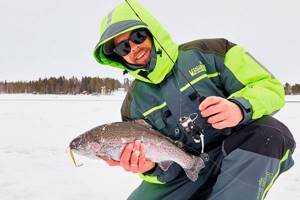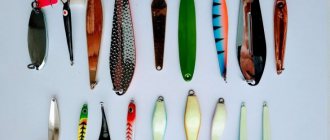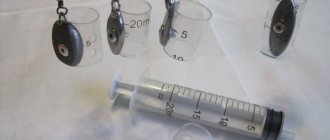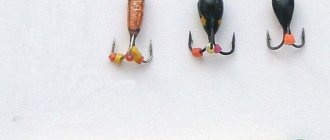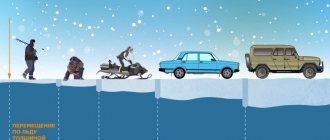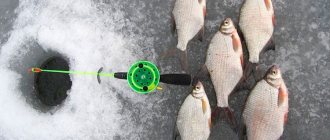At the same time, some fishermen prefer only the summer fishing season, and only a small part of them fish all year round, including in winter. Many people are afraid of weather conditions and the fear of being on ice. But if you take winter fishing seriously, the catch can be no less than in spring, summer or autumn. In addition, being on ice will not be so dangerous.
What should a novice fisherman take with him on a fishing trip?
Winter fishing is a very serious activity that requires a careful approach to the organization process. It requires the following equipment:
- In winter, you should make sure you have thermal underwear and warm clothes, as well as warm shoes and a warm hat.
- Make or purchase gear for winter fishing in the store. As a rule, it is enough to make or purchase a winter fishing rod.
- We should not forget that you will have to hit holes, therefore, tools such as a stump and an ice ax are simply necessary. It would be better if you also got an ice drill.
- Without bait and groundbait, no fish have been caught lately. Therefore, you need to think about what kind of bait and groundbait you will need to take with you.
- Every winter fishing enthusiast should have a fishing box where fish and fishing accessories are stored.
- To make fishing comfortable, you need a folding chair. Many anglers use a fishing box for this, building a soft seat on the lid.
- Fish should not be thrown onto ice, especially in severe frost: it will simply freeze to it. As a rule, anglers immediately throw the fish into the box.
- To quickly clear the hole of small ice chips, you will need a scoop with holes.
- An echo sounder will not hurt, with the help of which it is easy to find fish sites, especially large ones.
- In winter, the fish must be fed. For this, it is advisable to have a feeder.
- When catching large fish, you simply cannot do without a tool such as a hook.
- To store bloodworms (the main bait in winter), you must have a special container.
- To make fishing comfortable, you need to take care of protection from wind or precipitation. A tent will help solve this problem.
- The tent should be equipped with a camping mat, which will reduce fatigue from prolonged sitting.
- As a rule, fishermen often think about their safety and take various devices with them in case they fall through the ice. Therefore, you need to think or get advice on what is better and more effective.
- If there is deep snow, it is quite difficult to move around the reservoir. Therefore, it is better to use a fishing sled or snowmobile.
- You also cannot do without a backpack or duffel bag, since you must always take with you a spare set of warm underwear and clothes in case the main set gets wet.
- It is very important to provide yourself with a warm drink in the cold, and only a thermos can help here. By the way, you can also take a warm lunch in a thermos if you plan to go fishing for a long time.
- You will need items such as rope and candles.
What else do you need for winter fishing?
So, you are dressed, you know the place where you will fish and you have selected the necessary gear, can you start fishing? Don’t rush, fishing is a delicate matter, there are still mandatory details...
Since the main action takes place on ice, it must be opened, this is done with a special device - an ice screw. The quality of the ice drill determines the time it takes to drill holes and the effort expended on it. You can drill holes manually or with an ice drill with an adapter for a screwdriver; it is much easier, but more expensive; for the first time you can definitely do it without a screwdriver. You can select and buy an ice screw here.
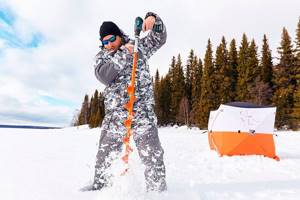
Another mandatory attribute for winter fishing is a winter box! It serves both as a place to store tackle and various fishing equipment and food supplies, and as a place to sit.
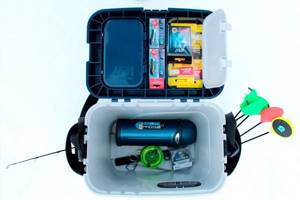
Don't forget to put a slotted spoon in the box - a scoop for removing ice from the hole. It is convenient to store bloodworms in a bloodworm container; you can buy it here. And for jigs, spinners and other baits there are special boxes and covers.
How can you take all this with you? It's all very simple - there are special fishing sleds, you load all your things into them, including an ice auger and a box, and drag them with you to the fishing spot by the rope!

Basic inventory listed! But in fact, you can continue the list of what you might need while fishing ad infinitum, here you can find winter tents, thermoses, gas burners, echo sounders, underwater video cameras, baits and attachments, and so on, so on, so on... Try it, and after the first fishing you will understand what exactly you need in order for fishing to take place in comfort, and the catches to become more stable and larger.
Cloth

Naturally, clothing is considered the main element of winter fishing. If clothes do not warm up properly, the fisherman risks freezing and getting sick. Hypothermia is always not advisable.
What clothes should be:
- If you wear clothes, then only heat-saving ones.
- An equally important factor is moisture resistance.
- You should also pay attention to its wind resistance.
- There should not be a lot of clothing, otherwise it will be difficult to move around the pond.
With the advent of thermal underwear on the market, which retains heat very well, there is no longer any need for excessive use. In other words, there is no point in putting extra layers of clothing on your body. This approach allows you to stay outside for a long time at sub-zero temperatures.
At the same time, we should not forget that winter fishing involves a lot of movement around the reservoir, including punching a large number of holes. This leads to increased sweating. In this regard, it is necessary to wear multi-layer thermal underwear that can wick away excess sweat. At the same time, it should be remembered that thermal underwear is always worn on a naked body, otherwise it will not work correctly.
The outerwear set should include warm trousers and a jacket, and felt boots should be worn on the feet. We should not forget about the headdress.
Having this type of clothing will allow you to fish all day in very low temperatures, in the presence of wind or precipitation.
What kind of fish do you catch in winter?
An experienced fisherman knows well not only what kind of fish bites in winter, but can also tell which species is best caught by month and even by decade.
At the beginning of winter, all the fish are still caught. In open water, fishing with a float in December brings good catches. But in the second half of the month, the fish begin to hibernate, and fishing efficiency decreases.
Predators are well caught: pike perch, burbot, perch, pike, worse - bream, gudgeon, chub, dace. Winter bottom fishing with a feeder is effective in December: you can catch crucian carp, carp, and roach.
Fishing in January brings excellent catches. At this time, fishermen move to the ice; the fish bite well after several days of relatively warm (up to -10°C) windless weather. Pike and pike perch can be caught well with a zherlitsa - sensitive tackle, and bream and perch - with a jig.
At the end of January and the first ten days of February, biting activity dies down, but in the second half of the month, as the day length increases, it becomes more active again. At this time you can catch pike perch, perch, and ruff. Pike are still inactive. By the end of the month, the activity of grayling, trout, bream, ide, roach, and chub increases.
According to the first ice
First ice is a short period of time: 10-12 days from the moment the first frost hits. Fishing during this period is dangerous because the ice is still too thin. But fishermen always look forward to it, because it is one of the most productive biting periods of the year.
On the first ice, the best places for fishing are shallow waters with thickets of reeds, reeds, over flooded snags and stumps; later, when the thickness of the ice increases, you should move closer to the mouths of small rivers and places where springs emerge.
To catch ide you should look for a flat, deep stretch, for perch and pike - places near the cliffs in front of the holes, roach is found closer to open water at a depth of 1.5-2 m.
It should be taken into account that during the first ice, a lot of fish accumulate on the border of light and dark areas, i.e. where the border of transparent and matte ice is clearly visible. Dark ice is a good shelter for fish in case of danger. If the ice is dark along the entire edge, then fish should be looked for closer to open water.
In winter, fish bite on the first ice around the clock, for example, perch comes out to feed in the early morning, when it is still dark, and after 15:00 in the afternoon, burbot - after dark, ruff - at almost any time.
In the wilderness
In the European part of Russia, the wilderness occurs in February. The period received this name for many reasons:
- there is too much snow, so it is difficult to move to the fishing spot;
- short daylight hours;
- due to the large thickness of the ice, it is difficult to drill holes;
- low temperatures do not allow you to stay in one position for a long time;
- fish are least active during this period;
- many gears are useless at this time of year.
However, true lovers of fishing in winter and deep winter hunt for perch, ruffe, bream and roach. The success of fishing during this period largely depends on a good knowledge of the area, methods of fishing in winter, which imply information about how to fish correctly and what to fish for in winter, as well as the endurance and dexterity of the fisherman.
On the last ice
A unique indicator of the onset of the period of last ice is the activation of bleak, which rises from the bottom and begins to actively feed. Following the bleak, pike perch, roach, and bream become active during the thaw.
Fish should be looked for in river beds and stream confluences. However, fishing during this period is associated with many inconveniences:
- the fish becomes too active and unpredictable, which means it’s difficult to find a good fishing spot;
- Frequently changing weather also changes the feeding time of fish, which makes it difficult to find it;
- Most often, a good bite is observed where the ice has become very thin, which is unsafe;
- The search for fish is hampered by unevenly melting ice.
Availability of basic equipment
Basic equipment will allow you to conduct fishing at the proper level. Otherwise, fishing may not take place at all or may turn out to be very difficult, which will certainly lead to negative emotions. What is the main equipment?
Ice pick

This is a tool that you simply cannot do without when fishing and it is better not to go out on the ice at all. As a rule, with the help of this simple device, fishermen check the thickness of the ice. This is especially important if the body of water is unfamiliar.
Old holes covered with snow pose a great danger to anglers. With the help of a pick, such places can be easily identified. This tool comes in different sizes and weights. This makes it possible to select the pick individually.
You can make a similar tool for a fisherman yourself.
Ice drill

This tool greatly facilitates fishing, especially if the ice is thick enough. There are a huge number of models on the market, both domestic and foreign manufacturers. As a rule, most fishermen prefer imported samples. They have the best quality knives and more.
Unfortunately, it is not possible to make an ice auger at home, although it can be assembled from spare parts.
Fishing box

A fishing box is a universal device that can replace several elements. Basically, fishermen use it as a container for storing caught fish, for storing fishing gear and bait. In addition, he can hide several sandwiches. And sitting on it near the hole with a fishing rod in your hands is just as possible. The main requirements for this product are:
- Strength.
- Ease.
A winter fishing enthusiast can always be recognized by his fishing box.
Scoop

Also a necessary device. It’s not very comfortable to pick out crushed ice from a hole with your bare hands, especially in the cold, and even in windy weather. And here a scoop, made like a kitchen colander, will be an indispensable thing. You can make a scoop yourself by using a kitchen scoop, or you can buy one. You should choose from lightweight designs and those with a wooden handle. If the bailer accidentally falls into the water, it will always remain afloat.
Hook

A very useful thing when catching large fish. Without it, it is unlikely that it will be possible to fish it out of the hole, especially if the individual is larger in size. It’s not difficult to make such a device yourself; all you need is a piece of wire on which to place a wooden handle.
Feeder

Fish can be at any depth. To feed it and collect it at one point, in the area of the hole, a feeder of any design will be useful. It is enough to tie a fishing line or rope of the required thickness and length to it.
WHAT YOU NEED FOR WINTER FISHING. Tips for beginners. Answers to subscribers' questions
Equipment
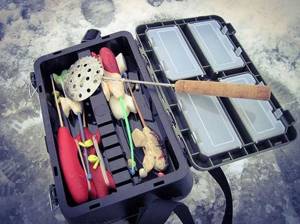
We've sorted out the clothes and shoes, let's move on directly to the fishing arsenal, main and auxiliary. Here you can give free rein to your imagination, read a lot of specialized literature and, sparing no expense, buy half the assortment of a fishing store. However, one must take into account that human strength is not limitless, and all this belongings will have to be carried on oneself. Even if you are driving a car, you will have to make a decent journey with your own legs and doubt the veracity of the saying that one’s own burden, they say, cannot be carried.
If you are going winter fishing for just a few hours, try to limit yourself to the most necessary set of equipment , including:
- tools for drilling holes;
- the actual gear (equipped fishing rods, fishing rods, spare equipment - depending on the fishing method);
- groundbait and groundbait;
- a fishing box (it can also serve as a high chair);
- a spare set of clothes (outerwear is optional, underwear and socks are mandatory);
- a thermos with hot tea, sandwiches or other travel snacks;
- hand towel (be sure to wipe them dry).
A tent, a heater, a tourist “foam” - this is all optional, but in windy weather and severe frost it definitely won’t hurt, not to mention a multi-day fishing tour.
Hole Making Tool
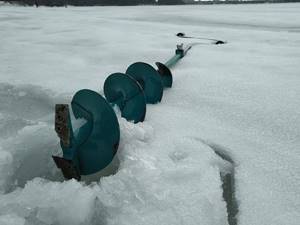
The most extreme moment of fishing is the foreplay, that is, drilling holes. It’s good if the reservoir already has ready-made holes, drilled by other fishermen earlier and only covered with a crust of ice. But usually you have to organize the fishing spot yourself, making holes in the ice with the tool you take with you. When winter fishing, sometimes you have to drill dozens of holes in search of a catchable place or to install girders, for example. Let's move directly to the tools:
- Ice pick . An ice pick is a kind of crowbar with a wooden handle, which is easy to make on your own. Previously, before the advent of ice drills, the pick was the fisherman’s main “ice-breaking” tool. Nowadays it is used mainly on the first ice, and not only for punching holes, but for the purpose of testing the thickness and reliability of the ice layer.
- Ice drill. The main tool for drilling holes is an ice auger. There are many models of this tool, including those with electric and gasoline engines. A beginner can get by with an ordinary domestic Tonar, which has the optimal price-quality ratio. True, before use it is better to “tune” a little, that is, to strengthen the tool: strengthen and adjust the knives, weld on the screw tape. If you don’t want to tinker, but have the means, it’s better to stick with the creations of Scandinavian manufacturers designed for drilling wet ice - they are, in fact, universal. Don't forget: you should always have a spare set of knives with you, just in case!
- Scoop . The scoop, of course, is not intended for drilling ice, but it is also impossible to do without it. As a result of working with an ice pick or ice drill, a hole is made, but it is filled with a kind of “porridge” consisting of ice fragments. Don't let your hands get cold, but you can't catch the porridge - a bulky scoop with a long handle will come to the rescue.
Fishing box
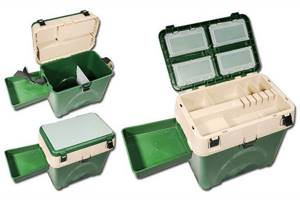
Thrifty fishermen make do with buckets and chairs, but such an approach can only be justified by the extreme poverty of the budget. One single device, a multifunctional fishing box, can solve a lot of problems. Previously, fishermen made boxes themselves (from plywood, tin and other available materials); now in specialized stores they are presented in a lot of variations.
The main requirements for an ice fishing box
are:
- Capacity. By capacity, in addition to volume, we also mean versatility. In addition to the main fish tank, there must be an additional tier, divided into sections. There you can lay out all kinds of gear, spare equipment, lures and bait, as well as a supply of provisions and a change of linen in plastic bags.
- Can be used as a high chair. This implies sufficient strength and stability - the box must support the weight of the fisherman. In addition, the lid should be equipped with a soft, insulated seat, because you will have to sit for several hours.
- Transportability. Modern fishing boxes, industrially made from durable and frost-resistant polymer materials, are lightweight. Additional ease of transportation is provided by a wide, length-adjustable strap that allows you to carry the box on your shoulder.
Tackle
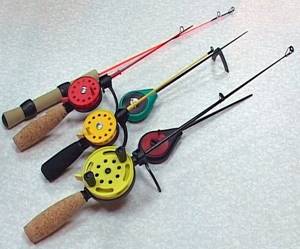
A winter fishing rod is fundamentally different from a summer fishing rod in design and size: it does not require a large length, since the angler is located directly in front of the hole. There are a lot of options for winter fishing rods, but for a beginner it is better to opt for a universal tackle with an open reel and a grippy handle. As an alternative, you can consider the “balalaika”, beloved by most winter fishing enthusiasts (the handle is a single unit with the reel), or a reelless rod with a “filly” type reel. A fishing rod with a reel can be assembled literally on your knee from a whip and a piece of polystyrene foam.
Most fishermen use the so-called “nod” (a soft and elastic sensitive tip) as a bite indicator, but there are also fans of float fishing. The thickness of the fishing line and other elements of equipment are selected depending on the type of fishing rod, type of fishing and size of the intended prey.
It is advisable to take with you a couple of equipped tackles plus spare leashes, which, if something happens, can simply be tied “loop to loop”, however, it is better to also have individual elements of the equipment in stock: sinkers, fishing line (main and for the leash), hooks, and so on .
At first, you can use a regular plastic bottle with holes equipped with a cable as a feeder. Subsequently, it is better to purchase a special winter feeder with a well-thought-out design, designed to ensure the simplest possible “charging” in the cold and delivery of food to the bottom.
If you intend to give preference to passive fishing methods, we recommend paying attention to girders. Ready-made baits can be purchased at the store (if you want to make them yourself), and no special skill is required in their use: it is only important to choose the right place, place the bait in the bottom layer of water and respond to signaling flags in time. Even trophy pike can be caught on girders, not to mention smaller predators.
Groundbaits and lures

In winter, all fish that do not hibernate go on a high-protein diet. This means that when preparing for fishing, it is better to give preference to bait of animal origin: bloodworms, maggots, worms, live bait. All this wealth can now be easily purchased in a store, rather than racking your brains about where to get worms and larvae in the winter.
Artificial gear is also used as traditional bait for ice fishing: jigs, winter spoons, and balance beams. Any fish that is able to swallow it will bite on a jig; on a balancer and a spinner, it is exclusively a predator. However, the use of artificial baits requires active play with the rod, which is quite problematic for a fisherman without experience. For the first time, it is still better to give preference to passive fishing with natural bait.
As bait, you can use a ready-made mixture purchased in a store, but you can prepare it yourself. A mix of rolled oats, cakes and breadcrumbs with the addition of culinary vanillin performs well. If you do not plan to use a feeder, it is better to prepare the mixture in advance with the addition of clay and water, rolling small but weighty balls from it. However, taking into account the winter gastronomic preferences of representatives of freshwater ichthyofauna, it is worth giving preference to bait based on chopped worms, bloodworms, jigs, and mayflies. Predator bait can be flavored with dry blood.
Additional equipment
We have already listed the basic equipment, but winter fishing is not an easy ride in warm weather, so it would be a good idea to take care of additional comfort for yourself. You can take with you:
- Backpack . Ideally, a good fishing box will hold everything you need for fishing, but if you want to take something beyond what you need, a backpack is a must. It is advisable to give preference to models made of waterproof fabrics in non-staining colors. Pockets on the flaps are welcome.
- Hook . When catching a large specimen in the summer, anglers use a landing net, otherwise the leader will break off. You can’t turn around in a hole with a landing net, but there is no need to land fish horizontally. In this case, a hook comes to the aid of the fisherman, which is used to hook the fish under the gills. Now on the market there are convenient compact models with telescopic handles that do not take up much space in your equipment.
- Tent . No tent without additional heating will protect you from severe frost, but it can easily protect you from the wind, which is what causes maximum discomfort in an open space. Frame models are characterized by the greatest strength, but their unfolding and dismantling takes a lot of time. Automatic tents are the most relevant and comfortable to use, while dome tents are the cheapest.
- Heater . The most popular among those who love winter fishing are gas heaters equipped with cylinders, stoves or air heaters. But there are models that run on alternative fuels.
- Tourist “foam” (mat) . The greatest invention of mankind is travel foam: lightweight, perfectly insulating, waterproof. You can find a place for it, even when going fishing on your own two feet, but you won’t freeze the most important parts of your body while sitting right on the ice.
- Echo sounder . To find places where fish accumulate, an echo sounder is vital, because every drilled hole is a waste of time and effort. In this case, there is no need for modern remote models with sophisticated electronic filling; a good old wired echo sounder is enough.
Tackle

For winter fishing you will need:
- A winter fishing rod with a 0.2 mm fishing line, the length of which (the fishing line) is about 20 meters.
- Small pellets, as cargo.
- It is very important to match the color of the hook to the color of the bait.
- To fish for bloodworms, you should take hooks No. 2, No. 3, No. 5 made of thin metal, since the body of the bloodworm has a thin body.
- The bloodworms are stored in a special container (bloodworm), which is not difficult to make yourself.
- For fishing with worms, hooks No. 3 and No. 4 are used.
- It is better to take several fishing rods with different equipment if different types of fish can bite.
- It is advisable to have spare hooks, fishing line, etc. with you.
Techniques for playing with a jig
- The experience of many anglers teaches that one of the most effective techniques for playing with a jig is continuous small twitches at the desired depth while simultaneously lifting to a height of half a meter.
- An equally effective technique is to place the jig on the bottom, and after a few seconds begin to rise with a small twitch. From a height of 10-15 cm they lower it to the bottom, then begin to rise again with a small twitch, etc.
- The jig is slowly lowered and twitched slightly. After it reaches the bottom, it immediately slowly raises it to a height of 1-2 m, also twitching slightly. This technique seems to be better than others at determining at what depth the fish is standing.
- With a small twitch, the bait is lowered and raised in the same way as in the previous case, but every 10-15 cm they stop for 3-5 seconds. Option: during a stop, stop playing for 3-5 seconds.
- The jig is quickly lowered to the bottom, as if knocked on it two or three times or more. At the moment of impact, a small cloud of turbidity rises, the current carries it away, the fish notices this and approaches the jig. The technique is called “soil stirring”. If it does not bring success, immediately switch to another technique or let the jig lie on the bottom for 3-5 seconds.
- When performing any technique, simultaneously move the fishing line from one wall of the hole to another. In this way, the bait is given another type of movement - horizontally. If the number of bites increases, you need to expand the hole: the wiring will be longer. However, if fishing is carried out at a depth of more than 3 meters, the horizontal movement of the jig usually does not bring any benefit - it either happens very slowly or cannot be achieved at all.
- This method of play is somewhat similar to vertical trolling. It consists in not allowing the bait to reach the bottom by 15-20 cm, sharply pulling it up, and then repeating this. Large predatory fish usually bite on this technique. In general, you should not jerk sharply - the fish is afraid of such movements. Raise and lower should be smooth, especially if fishing is carried out in winter.
- This method of play is similar to trolling: the jig is slowly lowered, occasionally, after 1-2 seconds, twitching a little stronger than usual. This is done until it touches the bottom, then with the same pushes it is lifted. This method is possible when fishing at a depth of 1-1.5 m.
- The bait is lowered to the bottom and slowly, without any twitching, raised. In this case, the nod can straighten - this is how a bream bites. Maybe in this case a nod and a bend means the ruff has pecked.
- Lower the jig to the bottom, slowly raise it to a height of 15-20 cm, here it vibrates for 10 seconds, then stops for 3-5 seconds. If there are no bites, this game is repeated at a different height.
- With the line stretched out, the jig is allowed to slowly fall, while at the same time quick short strikes are made with the index finger on the fishing rod. A variant of this technique: they also drum on the fishing rod when lifting the jig.
- The jig is lifted from the bottom with pushes to such a height as the hand of a sitting fisherman allows. In this way they check at what depth the fish is standing.
- After the bait has been lying on the bottom for 3-5 seconds, it is raised slowly at first, then faster and faster. Sometimes the move is delayed for a second. This technique is often beneficial when the bite is good.
- Having torn the jig from the bottom, slowly lift it, at the same time make small pushes and swing the fishing rod so that the fishing line swings from one wall of the hole to the other.
- This technique should be called “sophisticated.” It is used if you want to give the jig particularly slow movements. In general, this method is called “breathing”, but this is what it consists of. Hands are removed from the knees, elbows are pressed to the sides, the bait is at the depth where bites were last noticed. No movements are made - the jig moves only when the angler sighs. In this position, bites are expected for a long time - several minutes.
Experienced fishermen also use other techniques for playing with jigs. In most cases, these are combinations of the described methods or some variants thereof. This abundance is explained either by the characteristics of the reservoir, or by the peculiarities of the habits of the fish. However, in most cases this is the result of the subjective opinion of anglers: it seems to them that they have chosen the best methods. Still, you shouldn’t shy away from new techniques.
The sixth technique of playing with a jig involves moving the fishing line from one wall of the hole to another. It should be added that it is usually used on days of good light or when the ice is still thin and not covered with snow, a sheaf of light passes through the hole, and the fish is afraid to enter it and stands in the shade. The same result is achieved by using planning jigs, for example, lentils.
During the game, it deviates slightly from the vertical and may end up outside the illuminated area. In general, if you are fishing on the first ice or at shallow depths, you need to darken the hole: sprinkle snow in it and make a very small hole in it - enough for the jig to pass through. Sometimes the ice is so transparent that it is necessary to darken not only the hole, but also the area around it, since the fish are frightened by the movements of the angler’s hand.
Fishing without alcohol

Many fishermen take strong drinks with them, in the form of vodka or moonshine. Their main motivation lies in the warming effect of these alcoholic drinks. In fact, the effect can be completely opposite, and sometimes even sad.
Large doses of alcohol lead to the fact that the angler may fall asleep in the cold, and this is a serious risk of freezing. In addition, a drunk fisherman loses his reaction, which leads to ineffective fishing. It should also be remembered that not all fishermen returned home alive after such fishing.
Video: How to prepare for winter fishing
If you don't want to read, then this video is especially for you. In half an hour, the author of the video talks about everything, from shoes for ice fishing to the necessary gear.
Here's another video about what you need for ice fishing. Buying equipment from scratch, so to speak!
Friends, with this material we are launching a small series of articles in which we will look at each winter fishing accessory in more detail. Feel free to write your suggestions and questions about this in the comments. What would you like to know more about? Perhaps about choosing a winter tent?
The minimum you need for fishing

If you plan to travel for no more than half a day, then you can take a minimum amount of supplies, especially if there is no transport. For example:
- Warm clothes.
- Winter fishing rod.
- Groundbait and groundbait.
- Container for storing fish.
- Drill and scoop.
- A hook and a comfortable chair.
In other words, just dress warmly and take a fishing box with accessories.
Additional accessories
Those accessories that will be listed below are optional, but they can create additional comfort, which is so lacking in winter fishing. It should be remembered that transportation of some of them requires transport.
Heater

Naturally, the heater will only be useful if you have a tent. These are mainly gas structures, although there are products that run on other types of fuel.
As a rule, they do not differ in the principle of operation, but they differ in operating time. There are models designed for three hours of operation, and there are models that can heat the tent for all 5 hours. As a rule, gas models include a cylinder and a heater or stove.
Tent

If the fisherman has transport, he will definitely take a tent with him. In specialized retail outlets it is possible to purchase a tent for every taste. Here a lot depends on financial capabilities.
Tents are divided into 3 main types:
- Frame.
- Dome.
- Automatic.
The most reliable are frame structures, but the most practical are automatic ones, which take up a minimum of precious time for installation and dismantling. As for dome models, this is more of a budget option.
Basically, tents of light colors are chosen, since they provide the most light. The most important thing is that the tent can protect from frost, wind, and snow.
Echo sounder

We can say that these days an echo sounder is not an additional, but the main equipment of any fisherman. With its help, a minimum of time is spent searching for fish sites. You can drill 10 holes, or you can just drill one. As you can see, the expenditure of physical strength is disproportionately different. In addition, there is a lot of time left for fishing itself, but not for searching for fish. This is especially true in winter due to the short days.
What to wear for winter fishing?
Winter fishing is exciting, but since the action takes place in winter, the weather can sometimes be harsh, be sure to pay due attention to warm clothes. If you’re warm, you’ll enjoy it, but if you’re cold, you won’t even want to think about any fishing! If you have previously encountered winter sports (skiing, snowboarding, etc.), you probably know that they use special jackets and overalls made of membrane fabric, fishing is no exception! Winter fishing suits resemble ski suits, but are designed for less activity.
So, what clothes do you need for winter fishing?
1. Thermal underwear. This is a mandatory first layer of clothing for winter sports, be it skiing, fishing, etc. The right thermal underwear replicates the functions of your skin, retains the heat generated by the body, and in case of high activity, wicks moisture to the next layer of clothing, while remaining dry. You can buy thermal underwear for fishing here.

Thermal underwear options for winter fishing
2. Winter boots with isothermal liners. The expression “keep your feet warm”, familiar from childhood, comes in handy when fishing. Modern fishing boots are made of EVA material, which makes them light and comfortable. They feel like comfortable slippers. These boots are very versatile; in addition to fishing, they are convenient for walking the dog, traveling outside the city in winter, etc. You can buy winter boots here. For such boots there is no need to wear thick woolen socks; on the contrary, this can “ruin” the thermoregulation in the boots. It is better to buy special thermal socks; they are not expensive, but they perform the same functionality as thermal underwear - they remove moisture and retain heat.
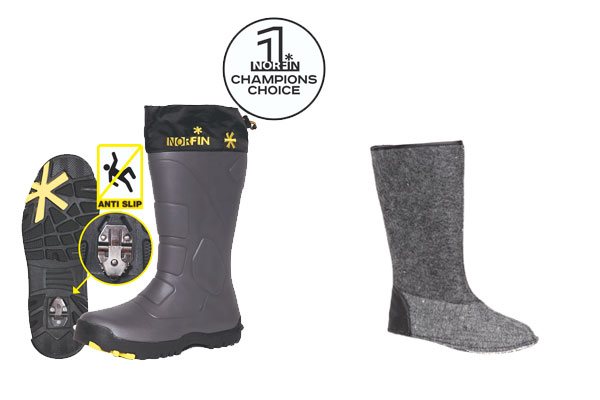
An example of Norfin Klondike winter fishing boots
3. Winter hat. It doesn’t require any additional explanation, but if you don’t have your own warm hat, you can buy a fishing hat here.

4. Mittens or gloves . There are several options here, the first is to purchase gloves or mittens, which you will have to take off when landing fish, setting bait, etc. The second option is special mitten gloves with a folding upper part; they are less warm, but more functional. You can choose mittens or gloves for winter fishing here.
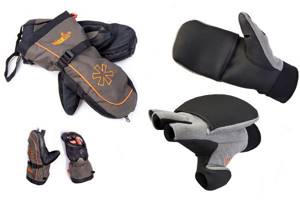
5. Suit for winter fishing. It should be noted that a specialized fishing winter suit is not a cheap pleasure, so if you are sure that you do not plan to get involved in fishing in the future, you should look for alternative warm clothes in your wardrobe. But if winter fishing becomes your hobby or even more, then know that fishing in a special suit becomes much more enjoyable. One of the most popular winter clothing companies among fishermen is NORFIN (Norfin), they have both men's and women's, as well as children's models. Suits are divided into different temperature conditions, usually from -15 to -45 degrees. Fishing suits are made from a special fabric - a membrane, which differs in two main characteristics, waterproofness and breathability. You can choose and buy a winter suit here.
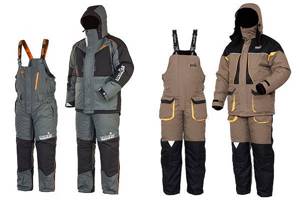
Winter fishing suits Norfin
Security measures

It is important to know the do's and don'ts during the winter fishing season. For example:
- It is not recommended to go out on thin ice. Statistics show that this is very life-threatening.
- You should always take an ice pick with you and move around the pond only with it.
- If you are not sure about the thickness of the ice, then you can move around the reservoir if you move your backpack or box on one shoulder. If something happens, you can easily free your hands and get rid of excess weight.
- If the ice begins to crack, you cannot run on it. You should lie down on the ice and crawl along it.
- If there is snow cover on the reservoir, you should be especially careful, as it can hide dangerous areas. And here the pick will be useful.
- It is strictly not recommended to move around the pond while intoxicated.
Tips from experienced ice fishing enthusiasts

When going to a winter pond, it is better to adhere to some rules. For example:
- At the moment you can buy a camera for winter fishing. According to some fishermen, this is a very useful thing. It will help you find out exactly where the fish are. It's like an echo sounder, but here you can see with your own eyes what kind of fish is in the area of the hole.
- Automatic tents have proven themselves well in conditions where you often move from hole to hole. If such a problem is not foreseen, then it is better to take a frame tent as it is more reliable.
- You should always take several fishing rods with you to catch different types of fish.
- When purchasing a tent, you should give preference to a design with windows. It is easy to ventilate, and there is always enough illumination and you don’t have to think about how to provide yourself with normal light.
A set of winter fishing gear for the novice winter fisherman.
What does the process of winter fishing consist of?
I'm ready to go fishing, what will happen there? Again, it all depends on the place and method of fishing, but the general plan looks like this:
- Arrival at the place; - Preparation of gear; - Drilling holes; - Feeding the fishing site (when catching white fish); - The fishing process; - Snack, tea; - The fishing process; - Cleaning up the area after yourself and rolling up the gear.
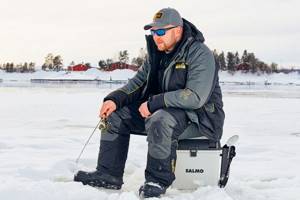
How about drinking? To be honest, winter fishing is not the best place to drink alcohol, but if you can’t imagine relaxing without drinking, it’s better to do it after fishing. Alcohol dilates the blood vessels, as a result of which the body begins to quickly lose heat. At first you will warm up, and then you risk quickly freezing without noticing it and getting sick. It's still better to have warm tea or coffee.
